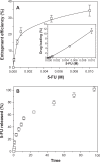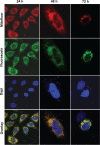5-Fluorouracil-loaded poly(ε-caprolactone) nanoparticles combined with phage E gene therapy as a new strategy against colon cancer
- PMID: 22275826
- PMCID: PMC3260954
- DOI: 10.2147/IJN.S26401
5-Fluorouracil-loaded poly(ε-caprolactone) nanoparticles combined with phage E gene therapy as a new strategy against colon cancer
Abstract
This work aimed to develop a new therapeutic approach to increase the efficacy of 5-fluorouracil (5-FU) in the treatment of advanced or recurrent colon cancer. 5-FU-loaded biodegradable poly(ε-caprolactone) nanoparticles (PCL NPs) were combined with the cytotoxic suicide gene E (combined therapy). The SW480 human cancer cell line was used to assay the combined therapeutic strategy. This cell line was established from a primary adenocarcinoma of the colon and is characterized by an intrinsically high resistance to apoptosis that correlates with its resistance to 5-FU. 5-FU was absorbed into the matrix of the PCL NPs during synthesis using the interfacial polymer disposition method. The antitumor activity of gene E from the phage ϕX174 was tested by generating a stable clone (SW480/12/E). In addition, the localization of E protein and its activity in mitochondria were analyzed. We found that the incorporation of 5-FU into PCL NPs (which show no cytotoxicity alone), significantly improved the drug's anticancer activity, reducing the proliferation rate of colon cancer cells by up to 40-fold when compared with the nonincorporated drug alone. Furthermore, E gene expression sensitized colon cancer cells to the cytotoxic action of the 5-FU-based nanomedicine. Our findings demonstrate that despite the inherent resistance of SW480 to apoptosis, E gene activity is mediated by an apoptotic phenomenon that includes modulation of caspase-9 and caspase-3 expression and intense mitochondrial damage. Finally, a strongly synergistic antiproliferative effect was observed in colon cancer cells when E gene expression was combined with the activity of the 5-FU-loaded PCL NPs, thereby indicating the potential therapeutic value of the combined therapy.
Keywords: 5-fluorouracil; E gene; colon cancer; combined therapy; gene therapy; poly (ε-caprolactone).
Figures








Similar articles
-
Poly(butylcyanoacrylate) and Poly(ε-caprolactone) Nanoparticles Loaded with 5-Fluorouracil Increase the Cytotoxic Effect of the Drug in Experimental Colon Cancer.AAPS J. 2015 Jul;17(4):918-29. doi: 10.1208/s12248-015-9761-5. Epub 2015 Apr 17. AAPS J. 2015. PMID: 25894746 Free PMC article.
-
Enhancement of 5-FU sensitivity by the proapoptotic rpL3 gene in p53 null colon cancer cells through combined polymer nanoparticles.Oncotarget. 2016 Nov 29;7(48):79670-79687. doi: 10.18632/oncotarget.13216. Oncotarget. 2016. PMID: 27835895 Free PMC article.
-
Enhanced antitumor efficacy in colon cancer using EGF functionalized PLGA nanoparticles loaded with 5-Fluorouracil and perfluorocarbon.BMC Cancer. 2020 Apr 28;20(1):354. doi: 10.1186/s12885-020-06803-7. BMC Cancer. 2020. PMID: 32345258 Free PMC article.
-
5-Fluorouracil nano-delivery systems as a cutting-edge for cancer therapy.Eur J Med Chem. 2023 Jan 15;246:114995. doi: 10.1016/j.ejmech.2022.114995. Epub 2022 Dec 1. Eur J Med Chem. 2023. PMID: 36493619 Review.
-
Melatonin and 5-fluorouracil combination chemotherapy: opportunities and efficacy in cancer therapy.Cell Commun Signal. 2023 Feb 9;21(1):33. doi: 10.1186/s12964-023-01047-x. Cell Commun Signal. 2023. PMID: 36759799 Free PMC article. Review.
Cited by
-
Unlocking the Potential of RNA Nanoparticles: A Breakthrough Approach to Overcoming Challenges in Colon Cancer Treatment.Curr Pharm Biotechnol. 2025;26(7):992-1013. doi: 10.2174/0113892010285554240303160500. Curr Pharm Biotechnol. 2025. PMID: 38482614 Review.
-
Bacteriophages and phage-inspired nanocarriers for targeted delivery of therapeutic cargos.Adv Drug Deliv Rev. 2016 Nov 15;106(Pt A):45-62. doi: 10.1016/j.addr.2016.03.003. Epub 2016 Mar 17. Adv Drug Deliv Rev. 2016. PMID: 26994592 Free PMC article. Review.
-
Pluronic-Coated Biogenic Gold Nanoparticles for Colon Delivery of 5-Fluorouracil: In vitro and Ex vivo Studies.AAPS PharmSciTech. 2021 Feb 3;22(2):64. doi: 10.1208/s12249-021-01922-1. AAPS PharmSciTech. 2021. PMID: 33533992
-
Development and Optimization of Irinotecan-Loaded PCL Nanoparticles and Their Cytotoxicity against Primary High-Grade Glioma Cells.Pharmaceutics. 2021 Apr 13;13(4):541. doi: 10.3390/pharmaceutics13040541. Pharmaceutics. 2021. PMID: 33924355 Free PMC article.
-
Poly(butylcyanoacrylate) and Poly(ε-caprolactone) Nanoparticles Loaded with 5-Fluorouracil Increase the Cytotoxic Effect of the Drug in Experimental Colon Cancer.AAPS J. 2015 Jul;17(4):918-29. doi: 10.1208/s12248-015-9761-5. Epub 2015 Apr 17. AAPS J. 2015. PMID: 25894746 Free PMC article.
References
-
- Parkin DM, Bray F, Ferlay J, Pisani P. Global cancer statistics, 2002. CA Cancer J Clin. 2005;55:74–108. - PubMed
-
- Berrino F, De Angelis R, Sant M, et al. Survival for eight major cancers and all cancers combined for European adults diagnosed in 1995–1999: results of the EUROCARE-4 study. Lancet Oncol. 2007;8:773–783. - PubMed
-
- Bertolini A, Fiumano M, Muffatti A, et al. Acute cardiotoxicity from 5-fluorouracil: an underestimated toxicity. Minerva Cardioangiol. 1999;47:269–273. - PubMed
-
- Cooke JWB, Bright R, Coleman MJ, Jenkins KP. Process research and development of a dihydropyrimidine dehydrogenase inactivator: Large-scale preparation of eniluracil using a Sonogashira coupling. Org Process Res Dev. 2001;5:383–336.
Publication types
MeSH terms
Substances
LinkOut - more resources
Full Text Sources
Medical
Research Materials

